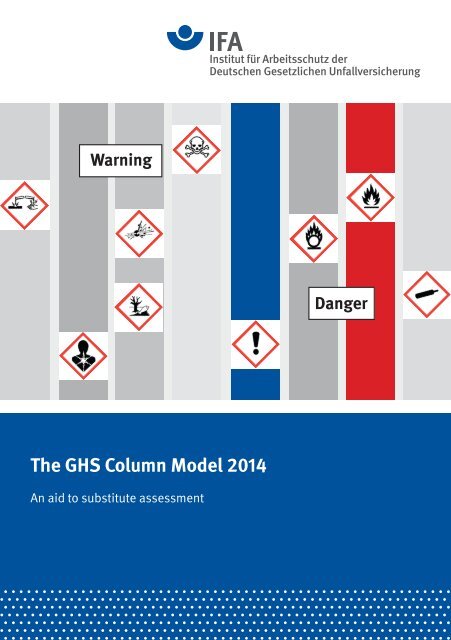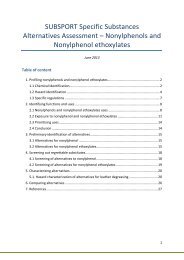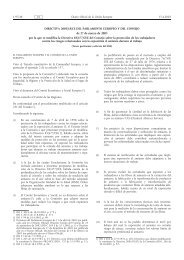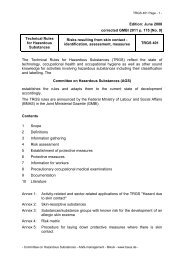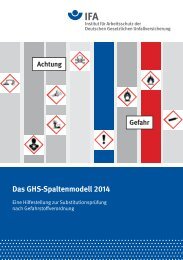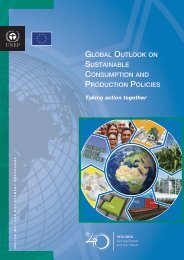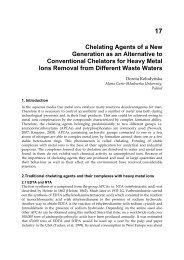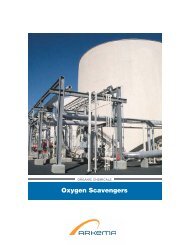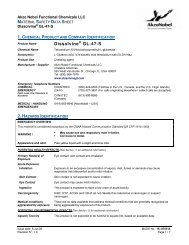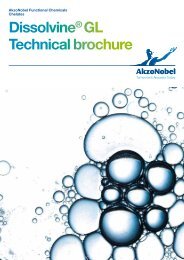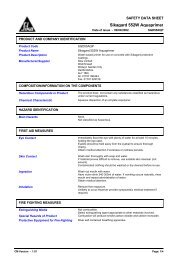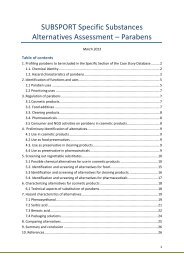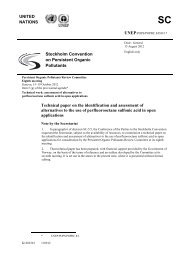leaflet (PDF, 510 kB) - DGUV
leaflet (PDF, 510 kB) - DGUV
leaflet (PDF, 510 kB) - DGUV
- No tags were found...
You also want an ePaper? Increase the reach of your titles
YUMPU automatically turns print PDFs into web optimized ePapers that Google loves.
1 Risk 2a Acute health hazards(single exposure)2b Chronic health hazards(repeated exposure)3 Environmental hazards 1)very high • Acutely toxic substances/mixtures, Cat. 1 and 2(H300, H310, H330)• Substances/mixtures that in contact with acidsliberate highly toxic gases (EUH032)• Carcinogenic substances/mixtures, Cat. 1A/1B(AGS: K1, K2, H350, H350i)• Carcinogenc activities orprocesses according to TRGS 906• Substances/mixtures mutagenicto germ cells, Cat. 1A or 1B(AGS: M1, M2, H340)• Substances/mixturesacutely hazardous to theaquatic environment,Cat. 1 (H400)• Substances/mixtureschronically hazardous tothe aquatic environment,Cat. 1 (H410)• Substances/mixtures ofGerman Water Hazard ClassWGK 3• PBT substances• vPvB substanceshigh • Acutely toxc substances/mixtures, Cat. 3(H301, H311, H331)• Substances/mixtures toxic in contact with eyes(EUH070)• Substances/mixtures that in contact with wateror acids liberate toxic gases (EUH029, EUH031)• Substances/mixtures with specific target organtoxicity (single exposure), Cat. 1: Organ damage(H370)• Skin sensitising substances/mixtures(H317, Sh)• Substances/mixtures that sensitise therespiratory organs (H334, Sa)• Eye-damaging substances/mixtures (H318)medium • Acutely toxic substances/mixtures, Cat. 4(H302, H312, H332)• Substances/mixtures with specific target organtoxicity (single exposure), Cat. 2: Possibleorgan damage (H371)• Substances corrosive to the skin(H314, pH ≥ 11,5, pH ≤ 2)• Substances/mixtures with corrosive effect onrespiratory organs (EUH071)• Nontoxic gases that can cause suffocation bydisplacing air (e.g. nitrogen)low• Skin-irritant substances/mixtures (H315)• Eye-irritant substances/mixtures (H319)• Skin damage when working in moisture• Substances/mixtures with a risk of aspiration(H304)• Skin-damaging substances/mixtures (EUH066)• Substances/mixtures with specific target organtoxicity (single exposure), Cat. 3: irritation ofthe respiratory organs (H335)• Substances/mixtures with specific target organtoxicity (single exposure), Cat. 3: drowsiness,dizziness (H336)• Substances/mixtures toxicto reproduction, Cat. 1A or 1B(AGS: R E1, R F1, R E2, R F2, H360,H360F, H360D, H360FD, H360Fd,H360Df)• Carcinogenic substances/mixtures, Cat. 2 (AGS: K3, H351)• Substances/mixtures mutagenicto germ cells, Cat. 2(AGS: M3, H341)• Substances/mixtures with specifictarget organ toxicity (repeatedexposure), Cat. 1: Organ damage(H372)• Substances/mixtures toxic toreproduction, Cat. 2(AGS: R E3, R F3, H361, H361f,H361d, H361fd)• Substances/mixtures with specifictarget organ toxicity (repeatedexposure), Cat. 2: Possible organdamage (H373)• Substances/mixtures that canharm babies via their mothers’milk (H362)• Substances chronically harmful inother ways (no H-phrase, but stilla hazardous substance!)• Substances/mixtureschronically hazardous tothe aquatic environment,Cat. 2 (H411)• Substances hazardous tothe ozone layer (H420)• Substances/mixtureschronically hazardous tothe aquatic environment,Cat. 3 (H412)• Substances/mixtures ofGerman Water Hazard ClassWGK 2• Substances/mixtureschronically hazardous tothe aquatic environment,Cat. 4 (H413)• Substances/mixtures ofGerman Water Hazard ClassWGK 1negligible • Safe substances on the basis of experience (e.g. water, paraffin and the like) • Substances/mixtures nothazardous to the aquaticenvironment(NWG, former WGK 0)1) The water hazard class is only referred to as an assessment criterion for substances/mixtures that have not (yet) beenclassified in terms of their environmental hazard properties.
4 Physico-chemical hazards(fire, explosion, corrosion et al.) 2)H-phrases marked in blue occur several times.• Unstable explosive substances/mixtures (H200)• Explosive substances/mixtures/products, divisions 1.1 (H201),1.2 (H202), 1.3 (H203), 1.4 (H204), 1.5 (H205) and1.6 (without H-phrase)• Flammable gases, Cat. 1 (H220) and Cat. 2 (H221)• Flammable liquids, Cat. 1 (H224)• Self-reactive substances/mixtures, Types A (H240) and B(H241)• Organic peroxides, Types A (H240) and B (H241)• Pyrophoric liquids or solids, Cat. 1 (H250)• Substances/mixtures which in contact with water emitflammable gases, Cat. 1 (H260)• Oxidising liquids or solids, Cat. 1 (H271)5 Hazards from release behaviour 6 Process-related hazards• Gases• Liquids with a vapour pressure> 250 hPa (mbar)(e.g. dichloromethane)• Dust-generating solids• Aerosols• Open processing• Possibility of direct skincontact• Large-area application• Process index 4 accordingto TRGS 500 (open designor partially open design,natural ventilation)• Flammable aerosols, Cat. 1 (H222)• Flammable liquids, Cat. 2 (H225)• Flammable solids, Cat. 1 (H228)• Self-reactive substances/mixtures, Types C and D (H242)• Organic peroxides Types C and D (H242)• Self-heating substances/mixtures Cat. 1 (H251)• Substances/mixtures which in contact with water emitflammable gases, Cat. 2 (H261)• Oxidising gases, Cat. 1 (H270)• Oxidising liquids or solids, Cat. 2 (H272)• Substances/mixtures with certain properties(EUH001, EUH006, EUH014, EUH018, EUH019, EUH044)• Liquids with a vapour pressure50 ... 250 hPa (mbar) (e.g.methanol)• Process index 2 accordingto TRGS 500 (partiallyopen design, processrelatedopening withsimple extraction, openwith simple extraction)• Flammable aerosols, Cat. 2 (H223)• Flammable liquids, Cat. 3 (H226)• Flammable solids, Cat. 2 (H228)• Self-reactive substances/mixtures, Types E and F (H242)• Organic peroxides, Types E and F (H242)• Self-heating substances/mixtures, Cat. 2 (H252)• Substances/mixtures which in contact with water emitflammable gases, Cat. 3 (H261)• Oxidising liquids or solids, Cat. 3 (H272)• Gases under pressure (H280, H281)• Substances/mixtures corrosive to metals (H290)• Not readily flammable substances/mixtures(flash point > 60 ... 100 °C, no H-phrase)• Self-reactive substances/mixtures, Type G (no H-phrase)• Organic peroxides, Type G (no H-phrase)• Liquids with a vapour pressure10 ... 50 hPa (mbar), with theexception of water (e.g. toluene)• Liquids with a vapour pressure2 ... 10 hPa (mbar)(e.g. xylene)• Closed processing withpossibilities of exposure,e.g. during filling, samplingor cleaning• Process index 1 accordingto TRGS 500 (closeddesign, tightness notensured, partially opendesign with effectiveextraction)• Process index 0,5according to TRGS 500(closed design, tightnessensured, partially closeddesign with integratedextraction, partially opendesign with highly effectiveextraction)• Non-combustible or only not at all readily flammablesubstances/mixtures(flash point of liquids > 100 °C, no H-phrase)• Liquids with a vapour pressure< 2 hPa (mbar)(e.g. ethylene glycol)• Non-dust-generating solids• Process index 0,25according to TRGS 5002) In view of their specific problems, explosive dusts must be tested in individual cases by a skilled person and have nottherefore been assigned to a hazard class.
Notes on Evaluating SubstituteSubstances by the Column ModelAre recommendations alreadyavailable on substitute substances?Answering the question of which product has thelower health risk is difficult. Recommendations fora whole series of questions regarding substitutesubstances can be applied directly, such as:• Technical rules for Hazardous substances in the600 series,• Recommendations “Exposure assessment of theGerman Social Accident Insurance Institutions”,• LASI-guidelines, series of BAuA• Product codes, GISCODEs,• Other industry guidelines.ProceduresProceed as follows:1. Copy the Column Model table once for eachproduct and note each product’s name ona different copy.2. Refer to the Material Safety Data Sheet for therequisite information. There you will find thehazard classes, H-phrases and the GermanWater Hazard Classes in Chapter 15 of theMaterial Safety Data Sheet and information onthe exposure potential in Chapter 9. You canalso find additional information in Chapters 3,5, 11, and 12.3. Note the information you find for the respectiveproduct on the copy of the Column Model table.Note the procedure used in the last column.4. Now compare the columns below separately foreach product to be evaluated:If there are no recommendations available to helpyou solve your substitute substance problem, theColumn Model can help you make a quick comparisonof substances and mixtures. To do so, you onlyneed the brief information found in the MaterialSafety Data Sheet or on the package labelling.––acute and chronic health hazards––environmental hazards––physico-chemical hazards––hazards from release behaviour––hazards caused by proceduresPlease bear in mind:• Comparisons are only to be made within acolumn, and never within a line. The columnsfor “acute health hazards” and “chronic healthhazards” count as one single column.• Also mixtures are assessed only on the basis oftheir labelling with respect to their acute andchronic health hazards.
Interpretation of the resultsOn the basis of the outcome of the risk assessment,a product must be substituted if it reducesthe risk to employees. A risk exists if employees arecapable of spatially and temporally encountering ahazard source (hazardous substance). The hazardsinherent in hazardous substances have to firstbecome effective (e.g. through exposure, fire, explosion)in order to become relevant risks.The columns 2, 3 and 4 constitute hazards. Thecolumns 5 and 6 are to be interpreted as „hazardsbecoming effective”.• If the potential substitute product rates betterin all five columns than the product in use, thesubstitution problem is solved.• It will mostly be the case that the potentialsubstitute product rates better in some columns,but worse in one or two to other columns. Thisobliges you to assess which potential hazards –in other words, which columns – play a larger rolein your particular situation. If, for example, sourcesof combustion cannot be excluded in yourproduction processes, then the fire and explosioncharacteristics together with the exposure potentialwill have the greater weight. If your productionmethods result in large quantities of wasteby-products, then the environmental hazards willbe emphasized.• Minor differences in the hazard classification onlyjustify the introduction of a substitute substanceif the data available for the substitute substanceis similar in quantity and quality to that of thesubstance being substituted.• In the event of opposing reasons, the differencein a single hazard classification may not besufficient for the introduction of a substitutesubstance.• Columns 2 to 4 (hazards) and 5 and 6 (hazardsbecoming effective) must always be assessedcollectively. If, for instance, a potential substitutesubstance is only a minor hazard according tocolumns 2 to 4, but the probability of a hazardbecoming effective according to columns 5 and6 is considerably greater, this substance may notbe suitable as a substitute substance.• With the Column Model, mixtures are notassessed on the basis of their components. Thepracticality of this procedure is obtained at theexpense of certain disadvantages resulting, forinstance, from the existence of classificationboundaries for mixtures.• For further interpretation of the results refer toTRGS 600 Annex 2.• Document your decisions in an appropriatemanner (e.g. by attaching the copies describedabove).Technical remarks• Explosive substances/mixtures and productswith explosive substances: All subclasses ofhazard category “Explosive substances/Mixtures/Products with explosive substances” are listedin the “Very high risk” line, as the subclass doesnot include any gradation of risk on the basis oftheir intrinsic properties, but subdivides substances,mixtures and products in their packagedform. In their unpackaged state, the risk from thesubstances/mixtures/products with explosivesin subclass 1.5 is in principle the same as that insubclass 1.1. A generally applicable statement onrecommended substitutes cannot therefore bemade within this hazard class.• Flammable gases: Categories 1 and 2 of the“Flammable gases” hazard category are listedtogether in the “Very high risk” line. Flammablegases of Categories 1 and 2 have an explosionrange and the same safety measures have tobe taken. Unlike flammable liquids, Category 2flammable gases should not be considered lesshazardous, and these substances/mixtures havebeen given the highest risk classification.
Conditions for Using theColumn Model according to TRGS 600What is the problem?What does this mean specifically?A supposedly less dangerous product can be moredangerous in reality; yet the concrete hazardouscharacteristics may not have been tested. For therisk assessment, the Hazardous Substances Ordinancetherefore states: “If no test data or suitablesound information are available on the acutelytoxic, irritant, skin-sensitizing or mutagenic effector on the effect due to repeated exposure, thesubstances or mixtures are to be treated in the riskassessment as hazardous substances with theassociated effects.” TRGS 600 therefore demands:“The Column Model must only be applied if themanufacturer has assessed the substances or mixtures(in terms of the health risk at least in termsof acute toxicity, skin irritation, irritation of themucous membranes, mutagenic potential and skinsensitization) on the basis of the available data andexperience with reference to any gaps in the data(see Safety Data Sheet, Chapters 9 and 11) and hasdeclared that hazardous properties exceeding thoseof the classification (particularly in terms of toxicityin the event of repeated application) are not beexpected on the basis of this assessment“.What effect does this have on the Column Model?1. If no information is available on tests for acutetoxicity, then the substance or mixture has to becategorized as a “medium risk” in the column“acute health hazards” (in terms of “acute toxicsubstances/mixtures, category 4“, H302, H312,H332). 1)2. If no information is available on tests of irritanteffects to the skin/mucous membrane, then thesubstance or mixture has to be categorized atleast as a “low risk” in the column “acute healthhazards” (in terms of an “skin irritant”, H315).3. If no information is available on tests for mutagenicproperties, then the substance or mixturehas to be categorized as a “high risk” in thecolumn “chronic health hazards” (in terms ofa germ cell mutagenic substance, category 2,H341).4. If no information is available on tests for skinsensitisation, then the substance or mixture hasto be categorized as a “high risk” in the column“acute health hazards” (in terms of a skin sensitizer,category 1, H317).If the information on required tests is unavailable,whereas the instructions in the Material Safety DataSheet are conform to the TRGS 600, “Yet, it is theexperience of the manufacturer that no hazards areto be expected beyond those on the label”, then theColumn Model can be applied without exception.The most consistent procedure is the one in whichthose products lacking information with regard tothe four basic tests described here are not evenconsidered as potential substitutes, or in whichproducts lacking such information are replaced byothers that are backed by studies and tests.If the Material Safety Data Sheet gives details onnone or only a few required tests and if an inquirywith the manufacturer has not yielded any information,then it must be assumed when using theColumn Model that the respective characteristicsare present.1)If no information is available on the acute toxicity, inthe risk assessment according to TRGS 400 protectivemeasures must be laid down for these substances on thebasis of the property Acute Tox.3 (H301, H311, H331).
The Legal Basisfor Finding SubstitutesThe Hazardous Substance Ordinance demands,among other things, the following from theem ployer:Article 6 (1) of the Hazardous Substances Ordinance:When conducting a risk assessment as part of theassessment of working conditions in accordancewith Article 5 of the Occupational Safety & HealthAct, the employer has to ascertain whether employeesare engaged in activities with hazardous substancesor whether hazardous substances may ariseor be released during such activities. If this is thecase, he must assess all the resultant risks to thehealth and safety of employees from the followingpoints of view: … 4. Scope for substitution …Article 7 (3) of the Hazardous Substances Ordinance:On the basis of the outcome of the substitution testin accordance with Article 6, Section 1, Sentence 2,Number 4, the employer must give priority to substitution.He must replace hazardous substances orprocesses with substances, preparations, productsor processes that are not hazardous or are lesshazardous to the health and safety of employeesunder the associated conditions of use.Edited by:Dr. Thomas SmolaInstitut für Arbeitsschutz der DeutschenGesetzlichen Unfallversicherung (IFA)Alte Heerstr. 11153757 Sankt AugustinGermanyTelefon ++49 (0)2241 231-2743Fax ++49 (0)2241 231-2234Internet: www.dguv.de/ifaWith participation of:Dr. Wolfgang Pflaumbaum (IFA)Dr. Eberhard Nies (IFA)Prof. Dr. Herbert Bender (BASF)Prof. Dr. Anke Kahl(Bergische Universität Wuppertal)Dr. Petra Schulte(BAM Bundesanstalt fürMaterialforschung und -prüfung)– March 2014 –
Deutsche GesetzlicheUnfallversicherung e. V. (<strong>DGUV</strong>)Mittelstraße 5110117 BerlinTelefon: 030 288763800Fax: 030 288763808E-Mail: info@dguv.deInternet: www.dguv.de


